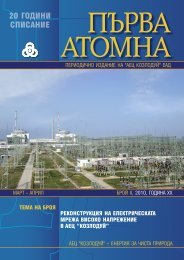Summary Report for Conduct of Kozloduy NPP Stress Tests
Summary Report for Conduct of Kozloduy NPP Stress Tests
Summary Report for Conduct of Kozloduy NPP Stress Tests
Create successful ePaper yourself
Turn your PDF publications into a flip-book with our unique Google optimized e-Paper software.
“<strong>Kozloduy</strong> <strong>NPP</strong>” PLC<br />
SUMMARY REPORT<br />
<strong>for</strong> <strong>Conduct</strong> <strong>of</strong> <strong>Kozloduy</strong> <strong>NPP</strong><br />
<strong>Stress</strong> <strong>Tests</strong><br />
6.3.3.4 I&C, required <strong>for</strong> monitoring <strong>of</strong> condition <strong>of</strong> fuel in SFP and <strong>for</strong> accident<br />
management<br />
I&C, required <strong>for</strong> monitoring <strong>of</strong> condition <strong>of</strong> fuel in SFP, are located at the MCR. At level<br />
reduction in the pools up to the controlled margin sound and light alarm actuates.<br />
6.3.3.5 Accessibility and habitability <strong>of</strong> the MCR<br />
Accessibility and habitability <strong>of</strong> the MCR are not limited at accident.<br />
6.3.4 Accident management after uncoverage <strong>of</strong> the upper part <strong>of</strong> fuel in the SFS pool<br />
6.3.4.1 Control <strong>of</strong> hydrogen<br />
According to the assessment per<strong>for</strong>med <strong>for</strong> complete loss <strong>of</strong> <strong>of</strong>f-site power supply and loss<br />
<strong>of</strong> emergency power supply, hydrogen accumulation is possible due to switching <strong>of</strong>f <strong>of</strong> the<br />
ventilation systems, but minimum air flowrate <strong>of</strong> 17,5 m 3 /h is sufficient to ensure concentration <strong>of</strong><br />
hydrogen above the surface <strong>of</strong> the pools does not exceed 0,4 % volumetric [25].<br />
6.3.4.2 Ensuring <strong>of</strong> adequate protection against radiation<br />
Executing <strong>of</strong> protection measures, envisioned in the emergency response plan, see<br />
par.6.1.3.1.4. <strong>of</strong> [28], ensures adequate protection against radiation.<br />
6.3.4.3 Limitation <strong>of</strong> releases after significant fuel damage SFS pool<br />
At emptying <strong>of</strong> fuel storage compartment, releases <strong>of</strong> aerosols and radioactive noble gases<br />
may not be localized, as in order to prevent damage <strong>of</strong> the fuel elements conditions are created <strong>for</strong><br />
efficient natural air circulation through the compartment [25], [113].<br />
6.3.4.4 I&C, required <strong>for</strong> monitoring <strong>of</strong> condition <strong>of</strong> fuel SFS pool and <strong>for</strong> accident<br />
management<br />
SFS has available with the following systems:<br />
· Monitoring system <strong>for</strong> radiation background above fuel storage compartments and<br />
SFS building.<br />
· Monitoring system <strong>for</strong> temperature and water level in compartments.<br />
· Leakage monitoring system.<br />
6.3.4.5 Accessibility and habitability <strong>of</strong> the control room<br />
[25].<br />
At complete drainage <strong>of</strong> the SFP compartments, control room in the SFS is not accessible<br />
6.3.5 Radioactive releases from dry spent fuel storage<br />
Beyond design basis accidents such as earthquake and flooding do not result in release <strong>of</strong><br />
the radioactive materials or to reduction <strong>of</strong> protective shielding provided by the containers in the<br />
DSFS [33].<br />
6.3.6 Measures which may be envisioned to improve possibility <strong>for</strong> localization <strong>of</strong><br />
radioactive substances releases<br />
6.3.6.1 Measures <strong>for</strong> Units 3 and 4<br />
194/202

















